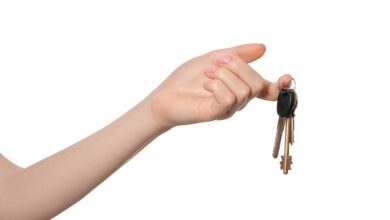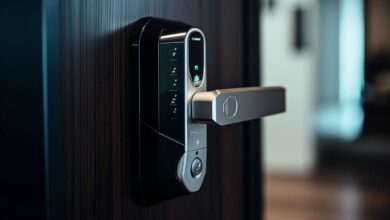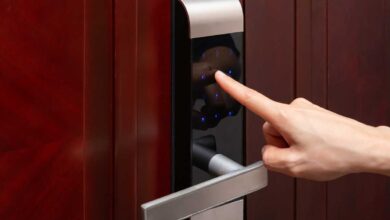Types Of Home Locks And Their Repair Methods
KEY TAKEAWAYS
In the intricate world of home security, locks stand as the first line of defense against potential intruders. From timeless deadbolts to cutting-edge smart locks, the variety available today is vast, each offering distinct levels of protection and convenience.
Understanding these different types and their unique repair methods is pivotal for homeowners aiming to fortify their sanctuaries. Dive in to unravel the complexities of home locks and their maintenance.
What are common reasons for home lock failure?
Lock failures at home, whether due to misaligned strike plates, wear and tear, extreme weather, or electronic malfunctions, can be a major inconvenience. Over time, doors and locks can become misaligned, internal mechanisms wear out, or technology glitches.
Cold conditions might freeze locks, while wooden doors can warp. Even a broken key can jam a lock. Addressing these issues promptly—through adjustments, lubrication, or professional help—ensures home safety and maintains lock functionality.
What to do when a lock fails?
Lock failures, whether from broken keys, misalignment, or electronic glitches, disrupt routines and threaten home security. If faced with a malfunctioning lock, stay calm and identify the issue. Avoid forcing a stuck key; use proper tools or call a locksmith.
Adjust misaligned locks, replace drained batteries in electronic locks, or consult manuals for troubleshooting. If the lock is severely damaged, consider a full replacement. When in doubt, trust a professional locksmith’s expertise.
Strike Plate Issues
One common reason for home lock failure that homeowners often overlook is issues with the strike plate. The strike plate is a piece of metal or plastic attached to the door frame that the lock bolt latches onto when the door is closed. It aims to provide stability and security by securely holding the lock bolt.
One of the most common strike plate issues is misalignment. Over time, the strike plate can become misaligned due to regular usage or the house settling. When this happens, the lock bolt may not correctly align with the strike plate, causing difficulty locking or unlocking the door. You may notice that the lock doesn’t engage smoothly or the bolt doesn’t fully extend into the strike plate.
Another issue with strike plates is loose screws. The screws that secure the strike plate to the door frame can become loose over time due to frequent use or vibrations. When the screws are loose, the strike plate can shift or move, making it difficult for the lock bolt to latch onto it properly. This can result in a weakened lock and potential security risks.
To address strike plate issues, it’s important to start by tightening the screws that secure the strike plate to the door frame. Using a screwdriver, carefully tighten each screw to ensure a snug fit. This simple step often resolves misalignment issues and improves the lock’s functionality.
If the strike plate is severely misaligned or the screws are stripped or damaged, it may be necessary to replace the strike plate altogether. Choose a new strike plate that matches the size and shape of the existing one and screw it securely into place.
If you’re not confident in your ability to fix or replace the strike plate, or if you’re experiencing persistent lock problems despite your efforts, it’s advisable to seek the help of a professional locksmith. A professional locksmith has the expertise and necessary tools to assess and address strike plate issues accurately, ensuring your lock functions properly and provides the security you need.
What is a strike plate?
The strike plate, though seemingly minor, is pivotal for door lock security and functionality. Fixed to the door frame, this metal plate receives and secures the lock bolt, ensuring a door stays shut when locked.
As the bolt extends into the strike plate, it forms a secure connection, offering resistance against forced entries. With various designs available, choosing a matching strike plate for the lock and door type is crucial. Typically crafted from durable metals like steel or brass, the strike plate endures the force from locking and door impacts.
Proper attachment to the door frame ensures longevity and consistent function. Misalignments or issues can compromise security, making it imperative to address them promptly. Understanding and maintaining strike plates is key to optimal lock performance and home security.
How can a faulty strike plate cause lock failure?
A strike plate is essential for door security yet often overlooked until lock issues emerge. This small component receives the lock bolt, ensuring the door stays securely shut. However, problems with the strike plate can hinder lock functionality and home security.
Misalignment, caused by regular use, house settling, or potential break-ins, can prevent proper lock engagement, leaving homes exposed. Moreover, wear and tear can weaken the plate, making locks unreliable or ineffective.
Forceful impacts or break-in attempts might also damage or break the strike plate, necessitating replacements for maintaining security. When encountering these issues, consulting a professional locksmith is paramount.
Their expertise can diagnose the problem’s scope and offer solutions, ranging from adjustments and replacements to upgrades. Ensuring a functional strike plate is crucial for door lock efficacy and home safety.
Signs of a faulty strike plate
Faulty strike plates can jeopardize your home’s lock security. Located on the door frame, the strike plate secures the lock bolt, but over time it can deteriorate. Key signs of trouble include misalignment, making doors feel loose or not locked properly, and visible wear like chipping or rust.
Forceful impacts or break-in attempts might crack the plate or loosen screws. If any of these issues are detected, it’s imperative to address them immediately. A professional locksmith can advise on adjustments, repairs, or replacements needed.
Regular inspections for misalignment, wear, or damage on strike plates can prevent security breaches. For optimal door security, maintain your strike plate and consult professionals when concerns arise.
Resolution: Fixing the strike plate issue
If your strike plate is misaligned or damaged, it’s vital to address it promptly for security. Simple misalignments can be fixed by adjusting the strike plate’s position using a screwdriver. Worn-out or damaged plates should be replaced, ensuring the new one matches the original’s size and shape. If DIY solutions seem daunting or ineffective, consult a professional locksmith.
Their expertise ensures accurate diagnoses and remedies, from adjustments to complete replacements. Addressing strike plate issues is essential for door lock functionality and home security. Whether making an adjustment, replacing the plate, or seeking expert help, act quickly to maintain security. A well-maintained strike plate is pivotal for preventing intrusions.
Professional Locksmith Services
Credibility and Licensing
Just as you’d be skeptical of receiving medical treatment from an unlicensed doctor, the same skepticism should apply when selecting a locksmith. Licensing isn’t merely a formal procedure; it’s an affirmation that the locksmith has undergone rigorous training and meets industry standards.
Furthermore, a valid license provides an assurance of accountability. It signifies that the locksmith operates within a legal framework, and in case of disputes or malpractices, there’s a governing body overseeing their actions. To put it simply, a license is a locksmith’s badge of credibility, reflecting their commitment to professionalism and upholding client trust.
Experience and Expertise
Consider the lock mechanisms of your home, car, and office. Aren’t they inherently varied in design and functionality? A seasoned locksmith recognizes these distinctions with precision. Their experience across different scenarios equips them with a nuanced understanding of diverse lock systems.
For instance, while anyone might be able to make a simple meal, it takes a chef to master culinary intricacies and deliver gourmet dishes. In the same vein, while many might claim to handle locks, only a skilled locksmith can adeptly navigate the complexities of various locking systems.
Positive Reviews and Testimonials
In our interconnected digital world, a business’s reputation is under constant public scrutiny. Online platforms serve as echo chambers, amplifying both accolades and criticisms. For locksmith services, this transparency is a boon for potential clients.
A reliable locksmith will invariably accumulate positive feedback, testimonials, and endorsements. Such commendations are not merely words; they’re stamps of approval from satisfied customers. And as the saying goes, while a single person might occasionally exaggerate, the collective voice of many satisfied customers seldom strays from the truth.
Tools and Equipment
Visualize an artist attempting to create a masterpiece but constrained by outdated or substandard tools. Their inherent talent might shine through, but the final artwork could fall short of perfection. This analogy aptly fits locksmiths too.
In an age where security systems are rapidly evolving, being armed with the latest tools is not just an advantage; it’s a necessity. Contemporary challenges demand cutting-edge solutions. A locksmith with state-of-the-art equipment is not just preparing to meet today’s requirements and is geared up for tomorrow’s challenges, ensuring efficient and timely service delivery.
When to hire an expert locksmith?
When securing your home, there are moments when a locksmith’s expertise is indispensable. While some minor lock issues can be DIYed, professional intervention becomes crucial in specific cases. Experiencing lock failures, like jammed or unresponsive mechanisms, signals a need for expert diagnostics and repairs.
Lockouts, whether from misplaced keys or accidental door shuts, require locksmiths to ensure non-damaging, efficient access. For worn-out or faulty locks, an expert can recommend optimal replacements or advanced systems like smart locks.
If your locks show signs of damage or misalignment, timely consultations can mitigate further issues. In essence, whether it’s for lock failures, replacements, or emergencies, relying on a seasoned locksmith ensures your home’s security remains uncompromised and trustworthy.
Benefits of hiring a professional locksmith service
Professional locksmith services offer invaluable benefits ensuring security, saving time, and avoiding extra expenses. Their extensive training equips them with knowledge on diverse lock types, from traditional to smart locks.
With a repertoire of specialized tools, they can address lock issues efficiently, preventing potential DIY mishaps. Their availability, often 24/7, ensures timely aid during emergencies, mitigating stress.
Beyond mere repairs, they enhance property security by offering key duplication, rekeying, and advanced security system installations. DIY attempts might lead to expensive errors; however, starting with a locksmith can sidestep these pitfalls.
Adhering to ethical standards, they prioritize clients’ security and privacy. In essence, for any lock issue, leaning on a locksmith’s expertise ensures top-tier, reliable solutions and peace of mind.
Tips for finding the right professional locksmith service
Selecting the right locksmith is vital for your property’s security. Prioritize locksmiths who are licensed and insured, guaranteeing professionalism and protection against potential damages.
Referrals and online reviews can provide insights into a locksmith’s reputation and service quality. Ensure they’re available 24/7 for emergencies and have prompt response times. A versatile locksmith, offering services from lock repairs to advanced security installations, ensures comprehensive solutions.
Lastly, seek transparent pricing; get upfront estimates to avoid unexpected costs. By considering these factors, you’ll secure a trustworthy locksmith, safeguarding your property efficiently.
Lock Mechanism Problems
Lock mechanism issues, common among homeowners, can jeopardize home security. Problems range from misaligned strike plates causing jams to worn-out internal components hindering smooth operation.
Weather conditions can freeze or corrode locks, while electronic locks may fail due to battery or component issues. Forcing a malfunctioning lock can escalate damage. Instead, consult a professional locksmith for efficient diagnosis and repair.
To prevent issues, regular maintenance using the correct dry lubricant is recommended. In essence, while various factors can disrupt lock function, proactive care and seeking expert assistance ensure continued security.
What is a lock mechanism and how does it work?
A lock mechanism ensures security by preventing unauthorized access. Central to it is the lock cylinder, which contains pins that align with the correct key, allowing rotation. This rotation engages or disengages the bolt or latch from the door frame.
Modern electronic locks use keypads, cards, or mobile signals instead of physical keys. Common lock issues arise from misaligned components, wear and tear, extreme weather, or electronic failures.
Addressing these issues quickly and conducting regular maintenance, like applying suitable lubricants, ensures the lock’s effectiveness. For optimal function and security, understand your lock’s basics and consult professionals for repairs or concerns.
Common door lock problems due to faulty mechanisms
A lock mechanism ensures security by preventing unauthorized access. Central to it is the lock cylinder, which contains pins that align with the correct key, allowing rotation. This rotation engages or disengages the bolt or latch from the door frame.
Modern electronic locks use keypads, cards, or mobile signals instead of physical keys. Common lock issues arise from misaligned components, wear and tear, extreme weather, or electronic failures.
Addressing these issues quickly and conducting regular maintenance, like applying suitable lubricants, ensures the lock’s effectiveness. For optimal function and security, understand your lock’s basics and consult professionals for repairs or concerns.
Signs of a Malfunctioning Lock Mechanism
-
Difficulty Turning the Key: Struggling to turn the key indicates possible broken internals, like worn-out pins or springs, impeding the lock’s function.
-
Stiff or Loose Lock: A wobbly or stiff lock suggests issues with internal mechanisms, potentially from loose screws or a misaligned bolt, compromising your security.
-
Key Resistance: If the key resists insertion or gets jammed, this points to issues like a jammed pin or a broken spring.
-
Unusual Sounds: Strange or grinding noises while using the lock can arise from misaligned or damaged components.
-
Key Breakage: A key breaking off inside the lock is a blatant sign of a malfunction. It’s advisable to seek a locksmith’s expertise rather than attempting an extraction.
-
Inconsistent Lock Operation: Fluctuating ease of lock operation indicates possible worn-out or misaligned internal components.
For any of the above symptoms, prompt action is vital. Postponing repairs amplifies damage and security risks. Consulting a professional locksmith ensures accurate problem identification and appropriate solutions. Regular maintenance, like lubricating the lock and checking for wear, can preemptively counter these problems, assuring both security and peace of mind.
FAQs
1. Why is my key difficult to insert or turn?
This often results from worn-out pins, springs, or misaligned internal components in the lock mechanism.
2. My lock makes a grinding sound. What should I do?
This suggests damaged or misaligned components. Consulting a locksmith is recommended.
3. Can I fix a jammed lock myself?
While some may attempt DIY solutions, professional assistance ensures correct and safe repairs.
4. How often should I maintain or lubricate my locks?
Regularly, at least once a year, and always use the proper lubricant for your lock type.
5. Is a broken key a sign of a faulty lock?
Not always. Keys can wear out and break, but it may also indicate a malfunctioning lock mechanism.
Conclusion
Recognizing and addressing signs of malfunctioning lock mechanisms is paramount for ensuring security. Regular maintenance and timely interventions, ideally by professional locksmiths, will prevent potential risks and provide peace of mind. Stay proactive in ensuring your locks are always in optimal condition.
Read more about the importance of finding a locksmith near you in case of car accidents or emergencies, by reading through our blogs at Security Forward.





